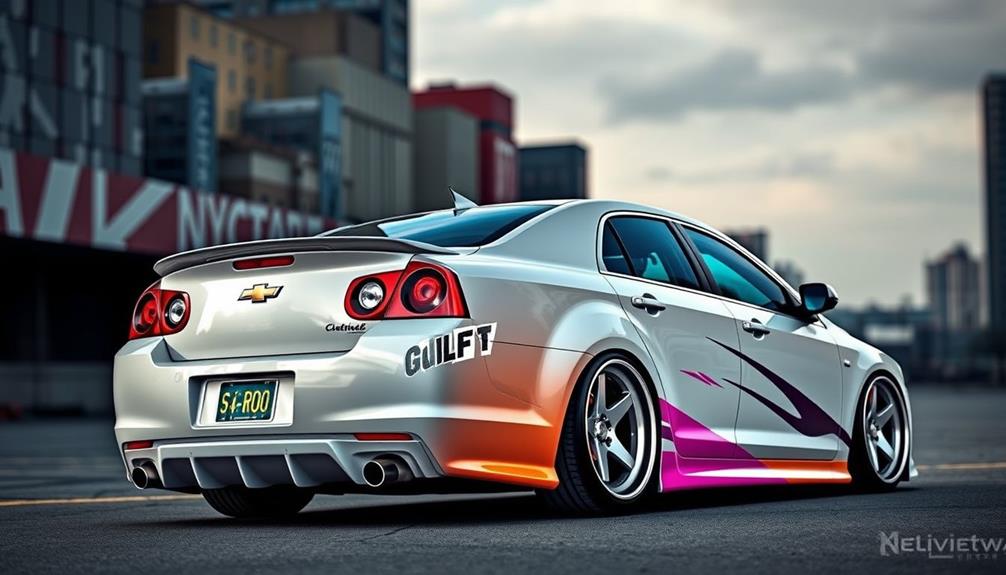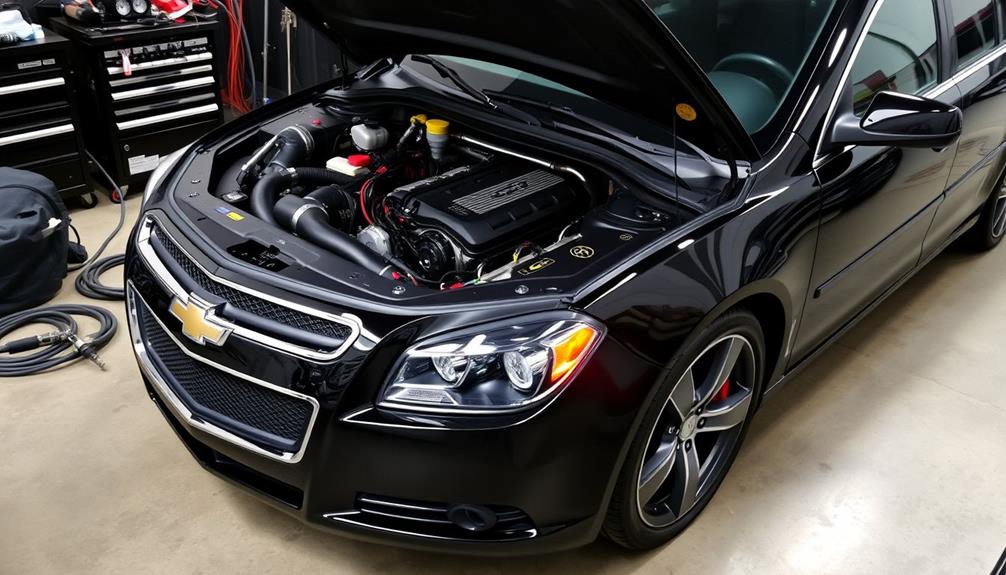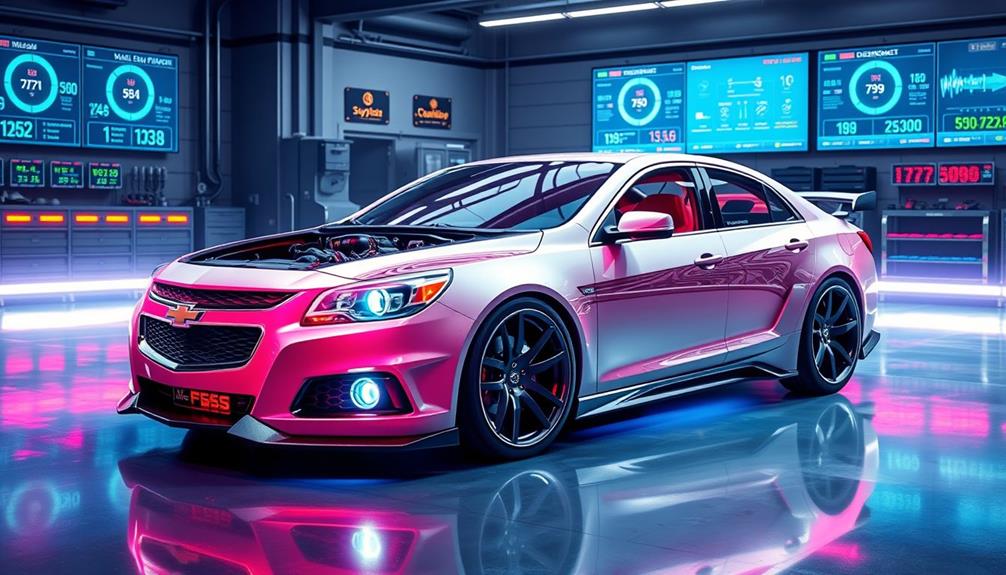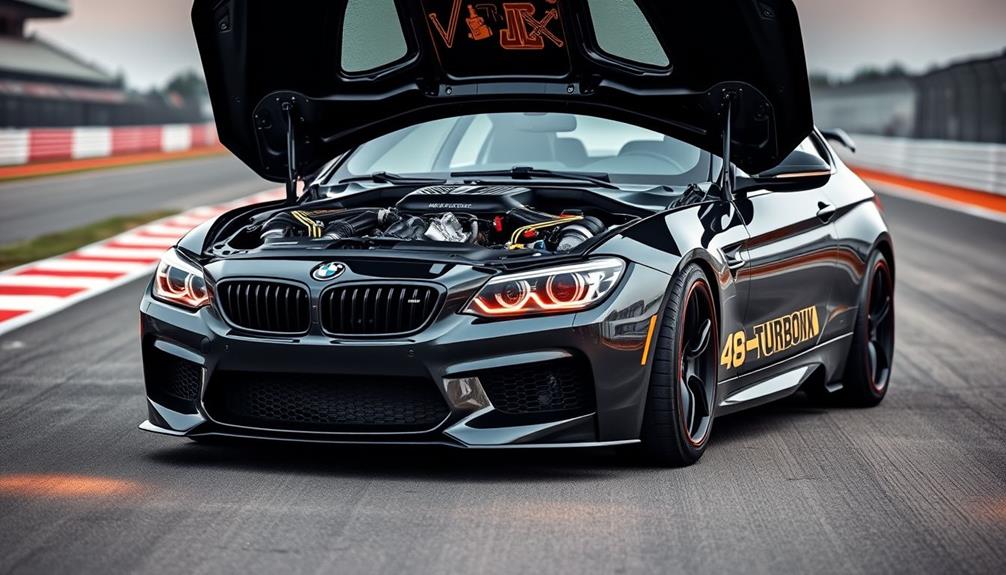You can easily boost the performance of your 2010 Chevrolet Malibu, transforming it into a more powerful and responsive ride. Start by using performance chip modules like Stage 1 or Stage 3 to release hidden horsepower and improve fuel economy. Consider adding a cold air intake and a custom exhaust system—they can increase horsepower by 15-20 combined. Don't forget to upgrade to high-performance tires for better handling. Regular maintenance, like checking your catalytic converter, also helps maintain peak performance. Curious about how to achieve even more power and efficiency? There's more to explore!
Key Takeaways
- Upgrade to HP Tuners for improved throttle response, especially beneficial for V6 variants, enhancing overall engine performance.
- Consider performance chips like Stage 3 for plug-and-play installation and significant power and fuel economy boosts.
- Install a cold air intake system to increase horsepower and torque by 5-10%, improving engine responsiveness.
- Pair a custom exhaust system with a high-flow air intake to enhance exhaust flow and increase power by up to 15 horsepower.
- Regularly monitor fuel efficiency with OBD2 tools to maintain optimal performance after tuning modifications.
Tuning Options for 2010 Malibu
When you consider tuning options for your 2010 Chevrolet Malibu, you'll find several effective solutions that can greatly enhance its performance. One popular choice is HP Tuners, which allows you to customize the vehicle's engine parameters for better responsiveness and throttle response, especially in V6 variants.
Another excellent option is Trifecta, known for optimizing your Malibu's performance while addressing common shifting issues, like delayed downshifting during acceleration.
By using custom tuning, you can create a smoother driving experience and possibly improve fuel economy alongside performance gains. Many users have noticed that optimized tuning settings help maximize horsepower and torque, especially when combined with performance modifications like cold air intakes (CAI) and custom exhaust systems.
Additionally, if you're aiming to enhance your Malibu's overall handling, consider upgrading to performance tires along with your tuning options. Such enhancements can boost your confidence at higher speeds, with reports indicating top speeds around 115-116 MPH.
Performance Modifications

When you're looking to boost your 2010 Malibu's performance, consider upgrading the engine tuning with a quality performance chip.
Pair that with a high-flow air intake and a custom exhaust system, and you'll notice significant improvements in horsepower and throttle response.
These modifications not only enhance power but also optimize overall engine efficiency.
Engine Tuning Options
For those looking to enhance their 2010 Chevrolet Malibu's performance, several effective engine tuning options are available. You can choose between the 2.4L I4 and the 3.6L V6 engines, with popular tuning solutions like HP Tuners and Trifecta. These options can greatly improve throttle response and resolve issues like delayed downshifting, especially in the V6 model's 6-speed automatic transmission.
Custom tuning can release your engine's potential, making your driving experience more responsive. If you're keen for more power, consider forced induction, such as supercharging the 2.4L engine, which can lead to considerable horsepower gains.
On the other hand, regular tuning and maintenance of your catalytic converter is important to prevent performance drops due to exhaust restrictions in the 2.4L variant.
Additionally, upgrading to a performance intake system is another engine tuning option that can boost horsepower and torque by 5-10%. This enhances overall engine efficiency and responsiveness, making your Malibu not just reliable but also a thrilling drive.
With these engine tuning options, you can maximize your Malibu's performance and enjoy a more exhilarating ride.
Exhaust and Intake Upgrades
Upgrading the exhaust and intake systems of your 2010 Chevrolet Malibu can greatly enhance its performance and driving experience. By installing a performance air intake system, you could see an increase in horsepower and torque by 5-10%, which boosts engine efficiency and responsiveness. A well-designed cold air intake will improve throttle response and acceleration, making your car feel more agile on the road.
Additionally, focusing on content relevance and authority can provide insights into choosing the best aftermarket parts for ideal results.
When it comes to exhaust and intake upgrades, consider a custom exhaust system that improves exhaust flow. This can lead to a power increase of 10-15 horsepower while giving your Malibu a more aggressive sound that turns heads.
Additionally, using performance air filters, like washable and reusable options, can enhance airflow to the engine, cutting down on filter replacement frequency.
To truly maximize your vehicle's potential, combine both intake and exhaust upgrades. They work in harmony to enhance engine breathing, yielding the best results.
With these modifications, you'll not only enjoy a noticeable boost in power but also a more engaging driving experience. So, gear up and get ready to transform your Malibu into a more powerful and efficient sedan!
Engine Specifications Overview

The 2010 Chevrolet Malibu offers drivers a choice between two capable engine options that cater to varying performance needs. You can opt for the 2.4L inline-4 engine, which produces 169 horsepower and features a 4-speed automatic transmission, or you can choose the more powerful 3.6L V6 engine generating 252 horsepower paired with a 6-speed automatic transmission.
This engine specifications overview highlights how both options are designed with a focus on fuel economy, allowing the 2.4L engine to achieve up to 30 MPG on the highway.
In terms of performance upgrade potential, the V6's advanced transmission enhances efficiency and responsiveness. Additionally, both engines incorporate high-quality technologies like variable valve timing (VVT), which improves performance and reduces emissions.
With a curb weight ranging from approximately 3,200 to 3,400 pounds, the Malibu's power-to-weight ratio offers respectable acceleration and handling characteristics, making it a versatile option for everyday driving.
Enhancing Tire Performance

Improving your 2010 Chevrolet Malibu's performance goes beyond just engine upgrades; enhancing tire performance plays an essential role in how your car handles on the road.
Upgrading to high-performance tires, like Michelin Pilot Sport A/S Plus, can greatly boost your vehicle's stability and handling, especially at high speeds. For the best results, use the recommended tire size of 245/45 R18 combined with Z-rated tires to enhance cornering confidence and acceleration.
To truly maximize tire performance, consider the following:
- Feel the thrill of improved grip, reducing your lap times.
- Experience greater confidence during spirited drives on winding roads.
- Enjoy the peace of mind that comes from regular tire inspections.
- Know your braking distances can be dramatically shortened with proper tire pressure.
Regularly checking your tire pressure and opting for dedicated summer tires can elevate your driving experience.
While all-season tires offer versatility, they may not match the performance of specialized options.
Chip Modules and Enhancements

When considering chip modules for your 2010 Chevrolet Malibu, you'll find options that can considerably boost your engine's power and torque.
These performance chips are easy to install, providing an immediate upgrade without extensive modifications.
Plus, they can enhance your fuel economy, helping you get more miles per gallon while enjoying a better driving experience.
Performance Chip Options
Revealing the hidden potential of your 2010 Chevrolet Malibu is easier than ever with a variety of performance chip options available. Among them, performance chip modules can greatly transform your driving experience.
Here are some exciting options to evaluate:
- Stage 1 Module: At just $99.99, this module uses advanced OBD-2 technology to release your engine's hidden power.
- Stage 3 Module: For $239.95, enjoy plug-and-play installation with an upgraded multi-core CPU that enhances performance seamlessly.
- Stage 4 Module: Priced at $299.95, this option includes an LCD monitor and additional features specifically for 2008+ Malibu models, perfect for those seeking extensive enhancements.
- Fuel Economy Benefits: Installing these chips can lead to notable improvements in miles per gallon, helping you save at the pump while boosting horsepower and torque.
Each of these performance chip modules is compatible with various Malibu models, ensuring straightforward integration without the hassle of complex installations.
By selecting the right chip, you're on your way to maximizing your Malibu's power and efficiency.
Don't wait—experience the difference today!
Installation Benefits
Installing performance chip modules not only releases your Chevrolet Malibu's hidden power but also comes with a range of benefits that enhance the overall driving experience.
For just $99.99, the Stage 1 Module can greatly boost your horsepower and torque, allowing you to feel the difference in acceleration and responsiveness.
If you're looking for even more performance, the Stage 3 Module, priced at $239.95, offers a plug-and-play installation with an upgraded multi-core CPU, ensuring improved safety and performance.
You might also consider the advanced Stage 4 Module at $299.95. This option includes an LCD monitor that further optimizes your engine performance for 2008+ models, giving you real-time feedback while driving.
Additionally, pairing your chip installation with a voltage stabilizer like the Mega Raizin Module, priced at $49.99, can enhance audio quality and make your performance tuning experience even better.
Fuel Economy Improvements
Many drivers are surprised to learn that tuning their 2010 Chevrolet Malibu with performance chip modules can lead to significant fuel economy improvements. By installing a Stage 1 Performance Chip Module, you can enhance your engine's performance, potentially maximizing your miles per gallon compared to stock settings.
The D1 Voltage Module, priced at just $39.95, improves both fuel economy and torque, making it a cost-effective choice for enhancing your sedan's efficiency.
To truly feel the benefits of fuel economy improvements, consider these enhancements:
- Experience the thrill of saving money at the pump.
- Enjoy longer drives without worrying about refueling.
- Feel the satisfaction of a more responsive engine.
- Take pride in an eco-friendlier vehicle.
Additionally, upgrading to a performance air intake system can improve airflow and fuel efficiency, allowing your engine to breathe better.
When combined with modifications like exhaust upgrades, performance chips can provide substantial fuel economy benefits. Regularly monitoring your vehicle's performance with tools like OBD2 code readers guarantees you maintain peak fuel economy, tackling any issues that might arise and further enhancing your Malibu's efficiency.
Community Insights and Experiences

Community engagement around tuning the 2010 Chevrolet Malibu reveals a shared quest for enhanced performance and driving enjoyment. Many owners, particularly those with the Malibu LS, express dissatisfaction with the factory shifting performance, which leads to active discussions about tuning options.
Users often turn to HP Tuners, reporting that it notably improves throttle response and overall vehicle performance. Additionally, the integration of AI technologies in vehicle performance is becoming more popular among enthusiasts, offering tailored solutions for tuning.
Custom tuning is frequently highlighted as an essential upgrade, especially for addressing delayed downshifting during acceleration, which can transform your driving dynamics.
Many community members have also found success with performance modifications like cold air intakes and custom exhaust systems, resulting in noticeable gains in horsepower and torque for their Malibus.
Moreover, there's a growing interest in supercharging the 2.4L engine among enthusiasts. This option is gaining traction as it promises remarkable increases in power output.
By sharing their experiences, members of the community contribute valuable insights that help you navigate the tuning landscape for your Malibu LS, ensuring you can maximize both performance and enjoyment on the road.
Engaging with fellow enthusiasts not only enriches your knowledge but also enhances your tuning journey.
Safety Considerations for High-Speed Driving

When it comes to high-speed driving, safety should be your top priority. Before you hit the gas, take a moment to confirm your Chevrolet Malibu is fully prepared for the demands of high-speed performance.
Consider these vital safety measures:
- Inspect your tires: Make sure they're rated for the speeds you plan to reach. Improper tire selection can lead to dangerous handling issues.
- Know your vehicle's limits: Be aware of manufacturer speed ratings to prevent mechanical failures that could jeopardize your safety.
- Address mechanical issues: Fix any existing problems before testing performance modifications, as they can increase your risk of accidents.
- Utilize proper safety features: Confirm your brakes and stability control systems are functioning well to enhance safety during high-speed maneuvers.
Engaging in high-speed driving should only occur in controlled environments like racetracks, where safety measures are in place.
Future Tuning Developments

As the tuning landscape evolves, enthusiasts can expect exciting developments for the Chevrolet Malibu, particularly the 2010 model. Future tuning may expand support for turbocharged I4 engines, giving you more options beyond the current V6 tuning available through platforms like HP Tuners and Trifecta.
Custom maps for tuning could become more accessible, allowing you to tailor performance adjustments that suit your Malibu's engine characteristics perfectly.
Community discussions are buzzing with interest in optimizing fuel economy, which could lead to innovative performance chips and modules designed to enhance your vehicle's efficiency. You might also see advancements in performance air intake systems that improve airflow, boosting engine efficiency for various 2010 Malibu configurations.
Moreover, the evolution of diagnostic tools and OBD2 technologies will likely enhance the tuning process. Real-time data logging features could become standard, enabling you to make precise adjustments and monitor your vehicle's performance closely.
Frequently Asked Questions
How to Increase MPG on Malibu?
To increase your MPG, consider regular maintenance like oil changes, proper tire inflation, and upgrading to low-rolling-resistance tires. You can also install a performance air intake system for better airflow and combustion efficiency.
What Causes Reduced Engine Power in Chevy Malibu?
Reduced engine power in your Chevy Malibu may stem from a clogged air intake, fuel system issues, a malfunctioning catalytic converter, or electrical problems. Regular maintenance and timely repairs can help restore your vehicle's performance.
Why Does My 2010 Chevy Malibu Hesitate When Accelerating?
When you press the pedal, does your Malibu feel like it's stuck in mud? That hesitation could stem from a faulty throttle sensor, clogged fuel filter, or ignition issues. Check those components to regain smooth acceleration.
Is 2010 a Good Year for Chevy Malibu?
Yes, 2010's a good year for the Chevy Malibu. It combines reliability, solid performance, and safety features. You'll appreciate the spacious interior and comfort, making it a great choice for daily driving or family trips.
Conclusion
In the quest for power, your 2010 Chevrolet Malibu can transform from a reliable sedan into a thrilling beast on the road. Think of tuning as a key releasing hidden potential, turning your everyday drive into an exhilarating adventure. By enhancing performance and embracing community insights, you're not just modifying a car; you're igniting a passion. So, take the wheel and steer your Malibu toward a future where every ride feels like a victory lap.










